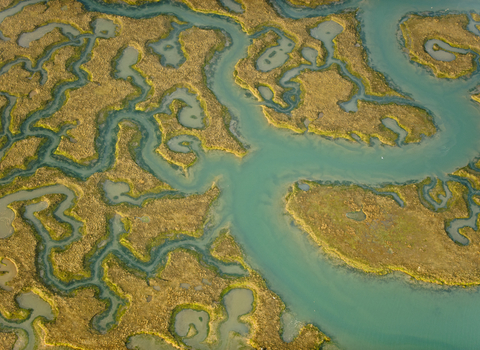What are saltmarshes?
In coastal areas sheltered from waves, slow moving tides gently lap over a flat expanse of fine mud, known as mudflats. Underwater at high tide and exposed during low tide mudflats support a wealth of life: bristle worms, bivalves (molluscs with two hinged shells) and mud snails - food for flocks of wading birds.
Towards land, in the absence of man-made structures, mudflats become saltmarshes - first vegetated with succulent samphire (harvested at some sites and considered a delicacy) and then with cord-grasses, sea purslane, sea aster and sea lavender as the mud becomes drier. Creeks and channels fan out through the saltmarsh, directing the water and flooding the lower marsh at high tide and draining away just as quickly as the tide drops.
Why are saltmarshes important?
Coastal wetlands, like saltmarshes, support abundant wildlife including migratory birds. Saltmarshes are special because the vegetation is adapted to cope with high levels of salt. Saltmarsh can attract rare species, such as spoonbill, glossy ibis and black-winged stilt and migrant visitors, including Brent geese. With so much wildfowl around, often birds of prey patrol these areas, including peregrine, merlin and hen harrier!
A natural solution to the climate crisis
Carbon is captured by plants growing in the saltmarsh through photosynthesis and is stored both in the plant and the sediment beneath, which can extend several metres deep. A hectare of saltmarsh can capture two tonnes of carbon a year and lock it into sediments for centuries. If the saltmarsh remains undisturbed the carbon in the soil can be stored for millennia!
Threats and pressures
We are losing nearly 100 hectares of saltmarsh a year. Not only that, threats such as drainage, development, and rising sea levels result in the loss and damage to coastal wetlands and saltmarsh, releasing CO2 into the atmosphere.
Conservation and recovery
The protection of remaining saltmarsh is a matter of urgency; but there is also potential to restore and create new habitat. ‘Managed realignment’ is one way of creating new habitat and is achieved by purposefully removing coastal defences or moving them further back in land. Plans to realign 10% of England’s coastal zone by 2030 would create 6,200 ha of habitat and increase carbon storage, as well as reduce risks of flooding and coastal erosion.









